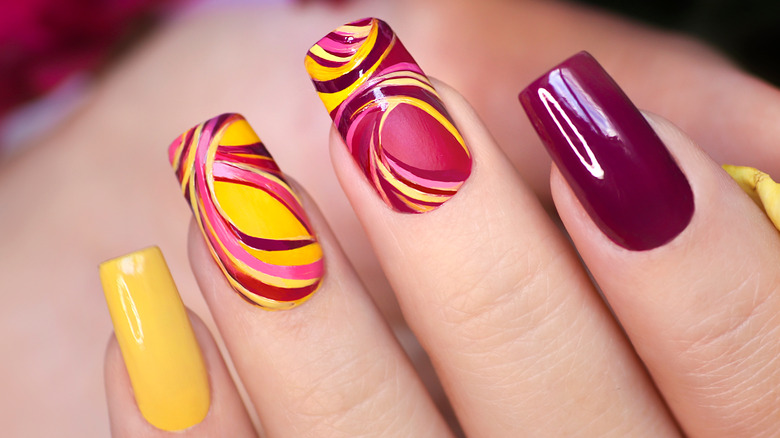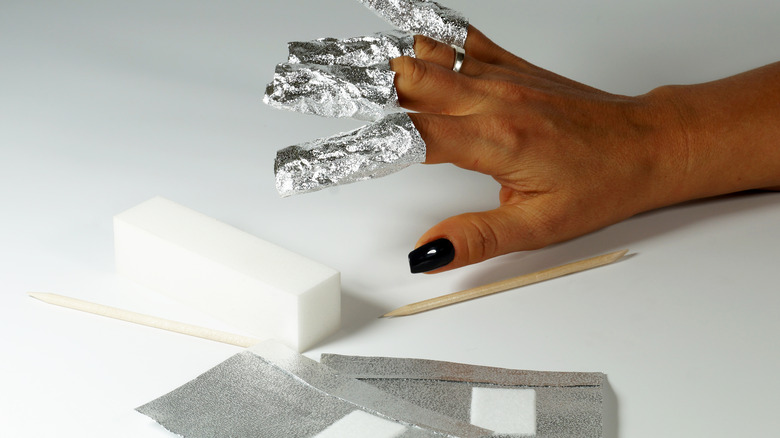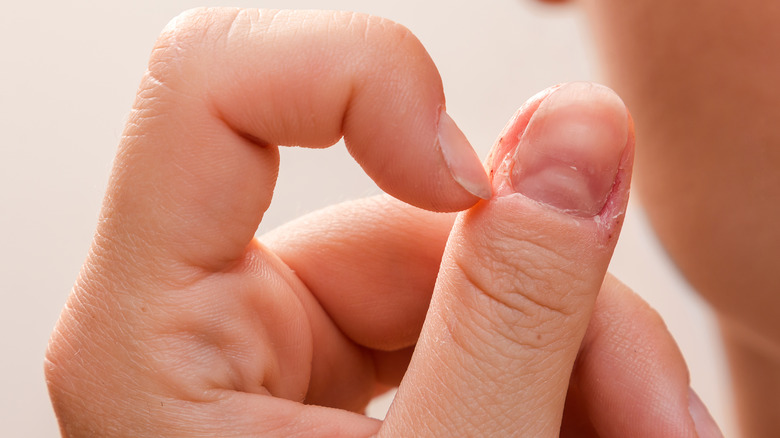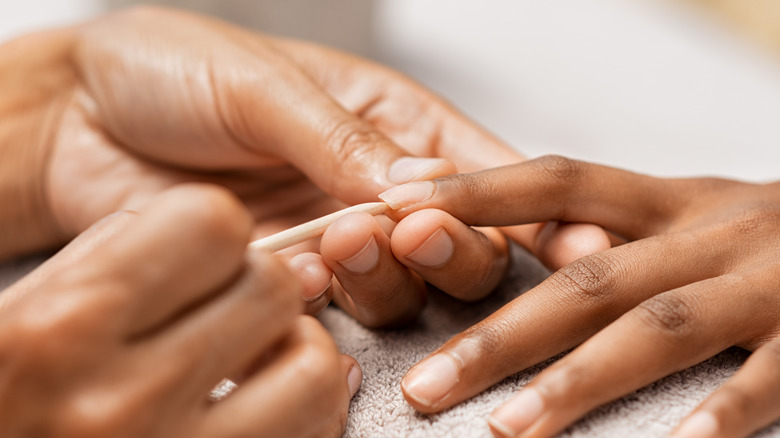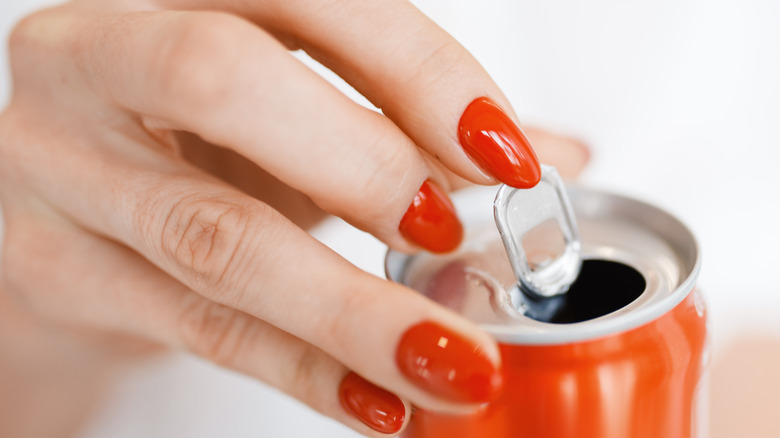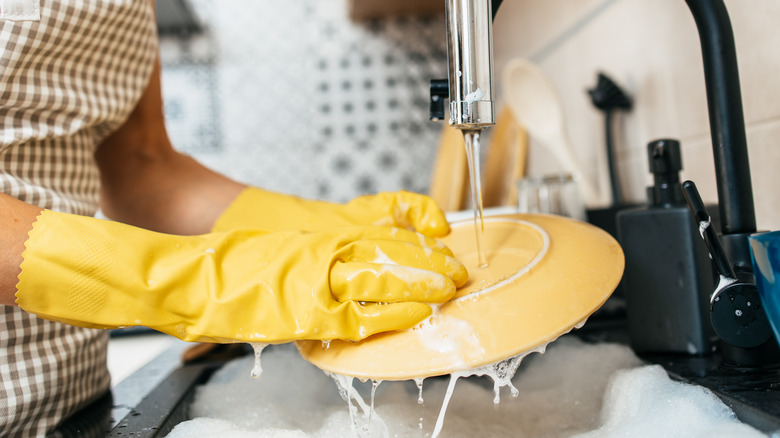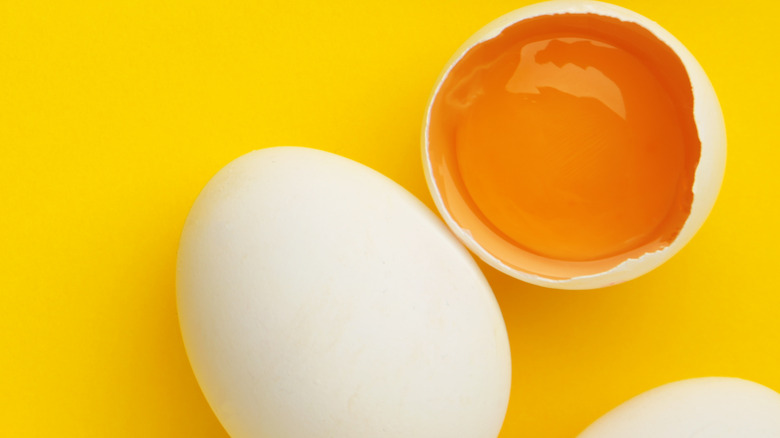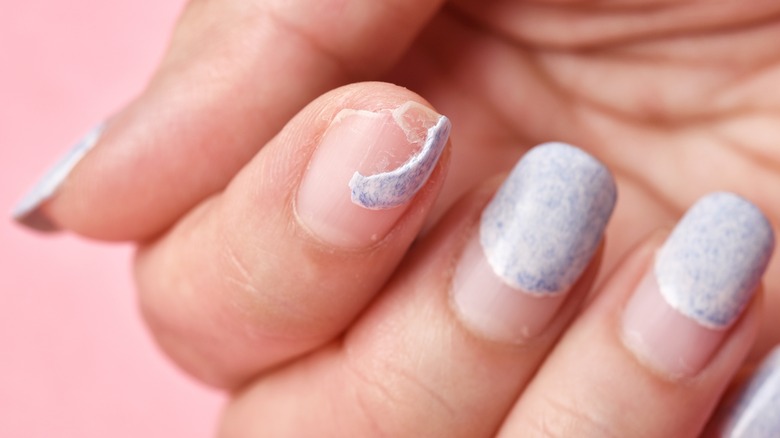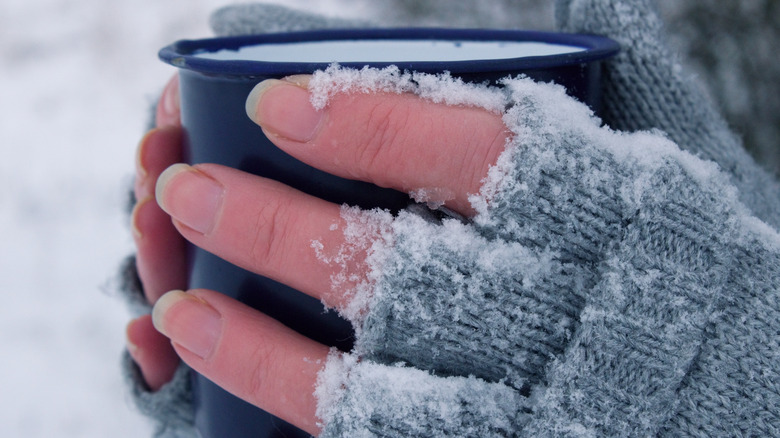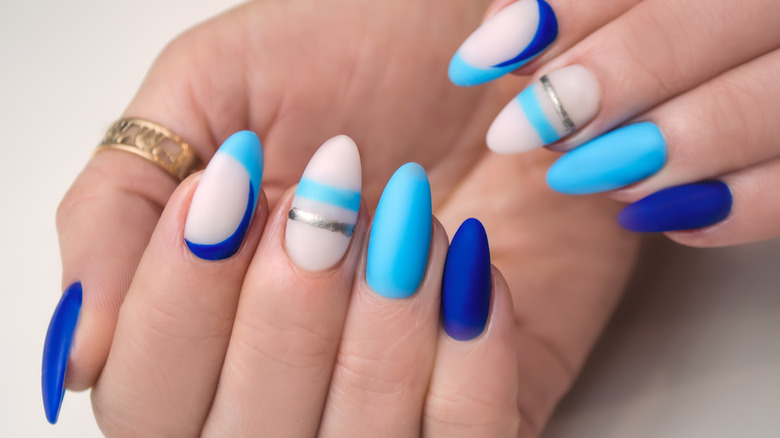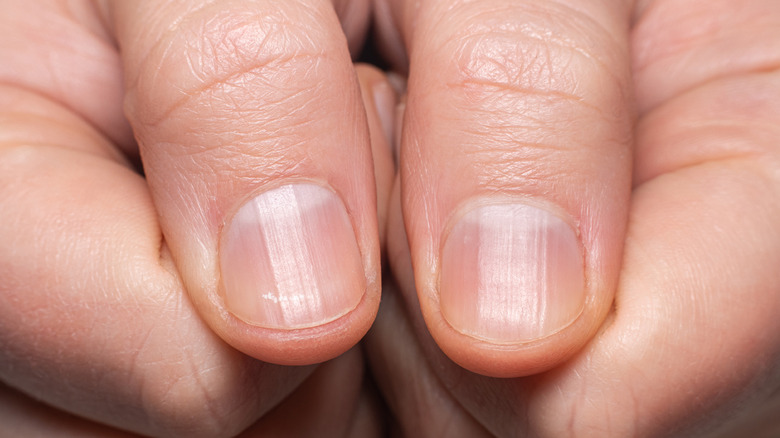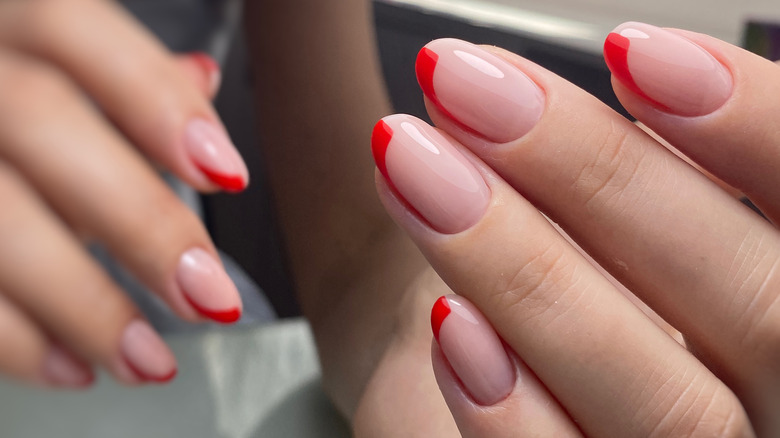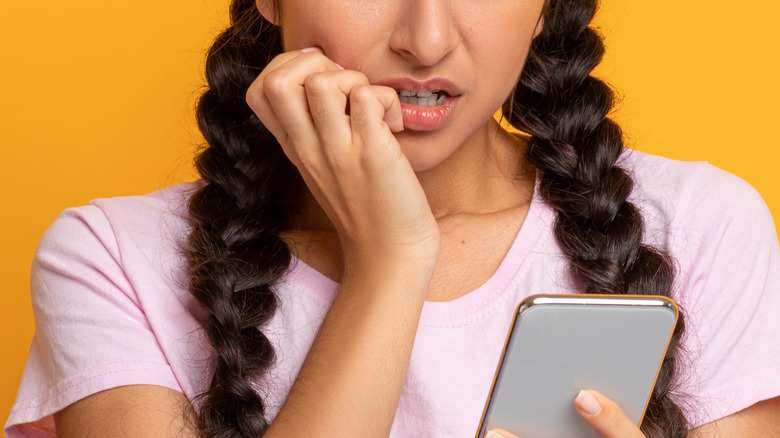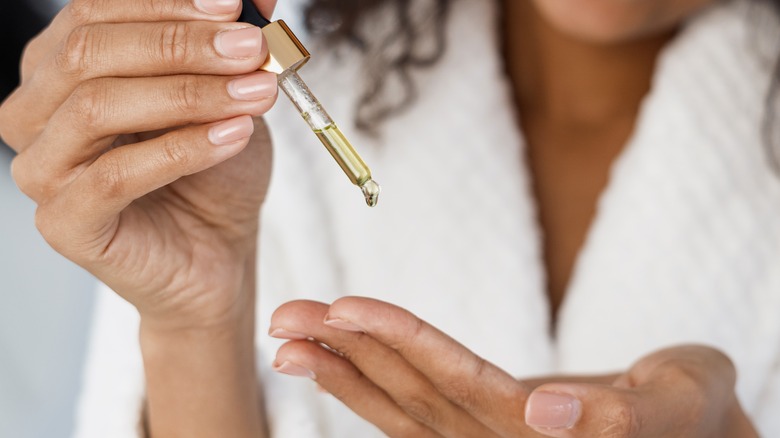14 Things You Didn't Realize Were Ruining Your Nails
Nails are serious business, folks. It's pretty amazing how much we spend on keeping our nails healthy and looking good. In 2018 alone, over 8.3 billion dollars were spent in nail salons, across 54,300 locations, according to Statista. And it appears we care as much about our nail appearance from the inside as we do from the outside, with the supplement industry for nails (as well as skin and hair) set to grow by over 10% each year until 2028 (per Data Bridge Market Research).
But frankly, we understand why people care so much about nails. As well as our nails serving important functions like making our fingertips stronger, protecting us from infection, and allowing us to perform tasks with greater ease (per Healthline), there's an indisputable pleasure in having well-cared-for, healthy-looking nails. But it might shock you to hear that although they look sturdy and strong, your nails are incredibly easy to ruin — and you might be doing so without even knowing it. That's why we decided, once and for all, to put a stop to unintentional nail destruction, and lay out all of the ways you might be ruining your fingernails.
Washing your hands too much
Maintaining good hand hygiene is essential for preventing the spread of diseases, from gastric flu to COVID-19 (per Better Health). But while you're busy keeping your loved ones from becoming ill, your nails might be suffering. Our nails tend to lose moisture more quickly than our skin, and washing our hands frequently can cause them to become less hydrated, says the Cleveland Clinic. This results in our nails becoming brittle, dry, and prone to breakage or weakness.
Using hand sanitizer can have a similar effect. Hand sanitizers are usually made of alcohol, and applying this to your nails regularly will leave them drier than before, according to Prevention. Instead, be careful about how often you're washing your hands and how you're using sanitizer. Try to keep your handwashing to essential, more high-risk moments, like leaving a public bathroom, before and after preparing food, and after changing a diaper, says Healthline. For hand sanitizer, being cautious is key. "If you have to use hand sanitizer, try not to get it on your nails, and don't overdo it," according to board-certified dermatologist Sheel Desai Solomon (via Prevention). Using hand sanitizer wipes may be an easier way to avoid getting alcohol on your nails.
Using acetone nail polish remover
If you paint your nails, you'll know how much work can go into finding the right materials and chemicals for you. But if you're debating which nail polish remover to use next, we highly recommend steering clear of acetone-based solutions.
Acetone can effectively break down your polish, and leave you with bare nails once more. But in doing so, your nails undergo some harsh treatment, say the experts at Sinclair Dermatology. "People often don't realise the damage we do to our nails is not from the polish, but rather the remover. Acetone exposure can cause your nails, cuticles and the skin around your nails to go red, dry and flaky," states Thea Phan, Nail Lab Nail Technician.
As such, using acetone nail polish remover can result in your nails becoming brittle, dermatologist Samantha Eisman says, who also points out that when acetone weakens the skin around the nails and causes breakage, it can lead to infection. If you're concerned about using acetone, it might be worth switching to a non-acetone-based polish remover. These might take a little longer to work at removing your polish entirely, but they'll do so in a kinder way to your nails.
Picking at your cuticles
It's tempting to treat our nails and our cuticles as the same entity, but in fact, they're separate parts of the same ecosystem. As our nails grow, our cuticles protect them, forming a barrier between our nail end and our nail root to stop bacteria from entering and potentially causing infection (per Healthline).
Unfortunately, our cuticles are pretty prone to damage, and also eminently tempting to pick. And here's where the trouble comes in for your nails. "That little moon shape at the base of your nails is called the lunula, and it's where a healthy nail originates. If you destroy it by picking, things can go awry," says Yale University associate clinical professor and dermatologist Mona Gohara (via Cosmopolitan). Your nail beds can end up warping out of shape, causing your nails to suffer. Picking your cuticles also opens the skin up around the nail, allowing the bacteria that collects on the nail to potentially make its way into your system and create an infection.
So, how do you stop picking your cuticles? Figuring out your triggers for doing so is an essential first step, so you can recognize when it's happening and try to catch it at the source. If you're more prone to biting your cuticles or nails, grabbing yourself a bitter-tasting nail serum to put around them can ward you off.
Not cleaning under your nails
We tend to focus on the top of our nails — making sure they're clean and shiny, giving them the perfect manicure, and covering them with the perfect coat of polish. But taking note of how they're doing on their underside is just as important, not least because failing to do so could compromise your nail health. Your nails accrue a lot of dirt and bacteria, and the underside is a particular site of this, according to the CDC. If you don't clean underneath your nails, they can become infected, leading to swelling, pain, or your nail becoming thicker.
Cleaning under the nail is especially important if you keep your nails long, as doing this gives them a greater surface area for bacteria to live on and thrive. To make sure they're staying as clean as can be, ensure that you're washing the bottom side of your nails whenever you wash your hands. You can also use a nail brush to get underneath them thoroughly. It's also worth keeping your nails slightly shorter, to avoid giving the bacteria a chance to thrive there in the first place.
Using nails as a tool
We've all done it: A can of Coke is particularly difficult to open, or a pin gets stuck in your corkboard and just won't come out. Enter the nail, nature's natural tool to prize open anything we please, with no consequences ... Or so we think.
While using your nail as a tool is certainly more convenient than going to grab a knife or a pick, it can also damage the nail and cause trauma to it, says Healthline. This may result in your nail peeling, which may lead to them becoming weaker, and therefore more prone to breakage.
Where it becomes complicated, however, is that sometimes, peeling nails can be caused by an internal, underlying condition. If you suspect this might be the case, there's an easy way to tell: Take a look at your toenails, and if they're peeling as well, it could be because of your internal health or diet. Regardless of whether your peeling is caused by external factors or not, though, it's best to bust out the tools next time you need to jimmy something open.
Not wearing gloves when you wash the dishes
Let's face it, very few people like washing the dishes. And to make matters even worse, not only is scrubbing your pots and pans a time-consuming bore, but it's also murder on your nails.
"Nails swell in water, which leads to chipped nails and weakened nail beds," says Butter London's global color ambassador Katie Jane Hughes (via Today). When you're soaking your nails in dishwater for extended periods, you're causing them damage. This is made even worse by high-strength washing detergent, which not only dries our hands and nails, but can also make your brand new nail polish job last for a shorter length of time, says celebrity manicurist Jin Soon Choi.
The solution? Put some gloves on. Using rubber gloves while you wash your dishes will create a barrier between your nails and the soapy water, protecting them from swelling and damage. It may also be worth investing in a hand-friendly soap that's not so hard on your nails. Prioritize finding one that will leave your dishes clean and your nails healthy.
Certain nutrient deficiencies
What we eat affects everything, from the largest parts of us to the smallest. And our nails are no exception to this: Our diet has a huge effect on our nail health and strength, and by omitting certain key nutrients from our plate, we could in the long-term set our nails up for failure.
One of the most important nutrients we need for nail health is biotin, says Healthline. Biotin, or vitamin B7, works alongside the amino acids in your food to build more robust, healthier nails — and failing to get enough of it from food sources like salmon, avocado, egg yolk, or organ meats can lead to nail brittleness.
Iron is also a key nutrient in healthy nail growth, as it ensures that oxygen can get to your nails and the other parts of your body. Not getting enough iron in your diet may lead to structural changes in your nails, as well as weakening of your hair and changes to your skin, according to research published in Seminars in Dermatology. Additional nutrients, like other B vitamins and magnesium, are also instrumental in nail growth. Lastly, ensuring that you get enough protein will also keep them strong.
Picking polish off
Okay, so we get it. We're always told that we can't pick our nails, but picking our nails is very tempting. So what about polish? Surely that should be fine to pick off, right (especially when it's time for it to come off anyway)?
Unfortunately, doing so is a habit that will quickly leave you with damage to your nails. "A lot of people start picking when their polish starts chipping instead of removing it with nail polish remover," says JINsoon Nail Polish founder and celebrity manicurist Jin Soon Choi (via Today). "This habit can remove the actual top layer of your nail bed, which sets the stage for weakened nails."
But as anyone who's ever tried to not scratch an itch will tell you, ignoring chipping nail polish when it's so tempting to pick is pretty hard. So if your polish starts to crack while you're out and about, carrying around a few pre-soaked remover pads with you can solve the problem without picking it away. It's also worth bearing in mind that if your nail polish is cracking all the time, you might want to spend a little extra on a high-end product that isn't so prone to deterioration.
Not adapting your nail care habit to the seasons
As the months roll around and the temperature changes, you might start to see a change in your nails. But unless you're reacting to it accordingly with your hand care, you may end up inadvertently causing your nails damage.
When winter starts to make everything a little rawer, "the exposure to the elements not only dries out the nails but may cause them to flake," says Deborah Lippmann, manicurist and owner of her eponymous nail product line, to Glamour. "Our nails naturally have a low oil and moisture content and therefore, they can become dry and brittle."
That's why it's so important to respond by upping your nail care game in the cold season. Taking supplements like vitamins that specifically bolster your nails, like folic acid and vitamins A and D, will promote health from within. It might also be worth investing in some cuticle and nail care products that are designed to strengthen the area. Remember, too, that as the harsh weather can dry out your nails and skin, you must moisturize your hands and nails regularly.
Keeping nail polish on for too long
If you've just found the perfect nail polish, you're going to want to keep it around. But sometimes, in doing so, it's entirely possible to keep your nail polish on for way longer than is advisable, and to immediately repaint them once it's started to fade or chip. And while you might not think that's a huge problem, it can be murder on your nails.
"It's not a good idea to leave nail polish continuously on your toes all summer. They need a break," stresses doctor of podiatric medicine Joy Rowland (via the Cleveland Clinic). When you do this, the nail polish can start permeating your nails and enter their top layers, and this can dry them out fast, potentially leading to infection.
Instead, you must give your nails a break. After keeping your nail polish on for a few weeks, allow them to be bare and unpolished for a fortnight or so. This will give your nails valuable breathing time to reset themselves and regain strength and moisture.
An underlying health issue
Changes to our health can manifest in some pretty unexpected ways. And you may be surprised to hear that your body's general state can have a huge impact on your nails and their strength and composition. Your nails can become weaker, for example, if you become deficient in certain nutrients, as Healthline states. Not getting a sufficient amount of fatty acids, calcium, or B vitamins can cause your nails to lose strength and be more prone to bending.
Other conditions may ruin your nails, and could even be a sign of something more serious. Horizontal ridges running across your nails could indicate that you're experiencing kidney disease, whereas brittle nails can be a symptom of hyperthyroidism. If your nails are looking especially yellow, this may be down to an infection, or your nails not liking the nail polish you're using and reacting to them — but it could also be a symptom of diabetes. Yellow nails may also be caused by psoriasis, which can also manifest itself through black lines down your nails. If you're at all concerned about your nails and suspect they might be a sign of a larger issue, it's vital to get in touch with your doctor.
Gel manicures
Gel manicures can seem like the smart choice for some people. After all, they dry quicker, you can get out of the salon faster, and they can last longer than a regular manicure, too. What's not to love?
Well, unfortunately, folks, that gel manicure you love so much might be destroying your nails without you even realizing it. "A study out of Miami School of Medicine used ultrasound to demonstrate that gel manicures do cause nail thinning," warns New York City-based nail specialist and dermatologist Dana Stern (via Marie Claire). While the precise reason for the thinning wasn't entirely discernible, the study, published in the Journal of Cosmetic Dermatology, found that nails were thinner, weaker, and more brittle in the subjects who had gel manicures which were then removed with acetone.
Another issue comes with the fact that gel manicures can be murder to remove, especially if hard gels are used, which can require rigorous filing off. The most important thing to do if you're getting a gel manicure is to ask your nail technician whether hardcore removal methods like sanding or filing will be necessary. "Gel polish should come off easily after soaking in acetone, and these methods can cause tremendous, and sometimes irreversible, damage to the nail and cuticles," Stern says.
Biting
Okay, we'll hold our hands up here: We're occasional nail-biters. We know it's not a great habit, but it seems pretty innocuous to us (if not a little gross). So that's why we were shocked to hear, as you will be, that biting your nails (also known as onychophagia) doesn't just ruin them in the short-term, but in the long-term, too.
"If you bite your nails, over time they will become deformed with bumps and ridges," states celebrity manicurist Jin Soon Choi to Today. By biting your nails, you can disrupt the matrix on which your nails are built and grow, and this can deform your nails or lead to ingrown nails that don't shift over time, says George Washington University associate professor of dermatology Adam Friedman (via Prevention).
It's also important to remind ourselves that nail biting isn't just a bad look — it's also really unhealthy. When you bite your nails, you're unintentionally ingesting all of the dirt and bacteria that reside under and around your fingernails, which can lead to infection and illness. Keeping your nails painted, or applying a bitter anti-biting solution, can help you break the habit.
Not keeping your nails moisturized
Most of us run to the moisturizer bottle at the first sign of dry, flaky hands. But when it's our nails, we can be slower to respond, and the ends of our hands don't tend to get the same amount of love as our skin does. "Hydration is crucial to our health in all facets—including our nails," says Deborah Lippmann, owner of the nail product company of the same name, to Teen Vogue. "Our nails are naturally low in oil and moisture content, therefore they can easily become dry and brittle."
Thus, you must be keeping them moisturized alongside your hands. While regular hand moisturizer will help them out a little, it's also important to recognize that your nails are made up of separate parts, and each of them will require its own type of care. A hydrating base product can be applied all over the nail, and then focus further on your cuticles with an oil or cream, Lippmann states. Doing this will keep your nails from drying out and splitting, particularly in cold weather. And naturally, don't forget about keeping your hands moist and well-hydrated, too!

